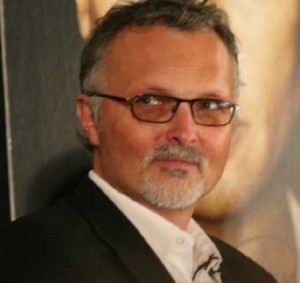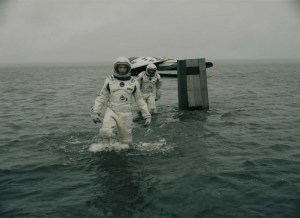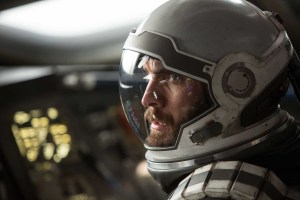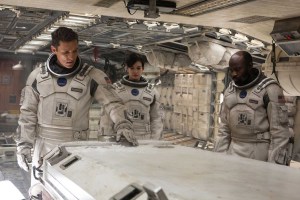
Though working with an established director such as Christopher Nolan would be appealing to most below-the-line craftspeople, it took a lengthy call from Nolan to editor Lee Smith to convince him to first join the ranks of Nolan’s crew on Batman Begins. “I had just finished editing Master and Commander in Los Angeles and got myself a U.S. agent,” Smith said by phone from London where he is now cutting the next James Bond film, Spectre. “They asked if I wanted to work on a Batman film, and I didn’t want to. [Chris and I] had an interesting chat for an hour. Chris was gauging my taste and what I liked and didn’t like about movies. After that, I went home to Australia, and my agent said, ‘You’ve got the job.’ We went on to do six films in a row.”
Over Nolan’s three Batman films, plus The Prestige, Inception and now Interstellar, Smith and Nolan have decidedly formed a healthy collaboration. “We have a great shorthand which we’ve built up over the years,” Smith explained. “We enjoy talking and reviewing the footage and investigating how you can make all of the changes editorially. We have similar tastes. They don’t align perfectly, but on the whole they align enough.”

Unlike Nolan’s earlier films with Smith as editor, Interstellar brings the pair into the territory of an abstract space epic, requiring a unique approach, especially to establish the film’s rhythm and pace over its 169 minutes. “We took our time with it,” Smith explained, citing the earlier films in contrast. “You really are packing a lot of information and speed in the Batman films. This film had a rhythm all of its own. It was a matter of keeping interest rolling along. We did test it numerous times and were pleased with the way the audience responded to the movie. We never had any negatives about the length. It holds its own.”
To achieve a measured pace for a film that bridges almost three hours, Smith points to Nolan’s economical shooting style as assisting him in the process. “Chris had the film very well-planned out in his head,” Smith related. “He has more of a clinical precision to what he’s shooting. He knows exactly what he wants and how to get it; he knows the end result. Other directors may change their minds and change coverage and the way the scene is going. He’s more planned in the way he executes. On that scale and complexity – Interstellar or Inception – if you weren’t on top of how that film would play out, it would be very complicated to edit. There’s always a way, in Chris’s coverage, to make it work.”
 One of Interstellar’s standout editing moments occurs when Matthew McConaughey’s astronaut character, Cooper, watches video messages of his children who have grown up over two decades in what to McConaughey seems like mere hours. “It is one of my favorite scenes, mainly because McConaughey, in take one of four takes, decided to not watch the video monitor before the cameras rolled,” Smith explained. “We had already cut the footage on the monitor. It was live footage. He responded in a real and emotion a way. You couldn’t cut away from him. As the scene continues, it does go backwards and forwards – the crisis of realizing that you’ve missed your entire children’s youth. The end of the scene – he reaches forward, the screen cuts blank, and we cut to Murph [his now adult daughter, portrayed by Jessica Chastain] recording that message. You think things are happening at once, but he is watching a message years prior.”
One of Interstellar’s standout editing moments occurs when Matthew McConaughey’s astronaut character, Cooper, watches video messages of his children who have grown up over two decades in what to McConaughey seems like mere hours. “It is one of my favorite scenes, mainly because McConaughey, in take one of four takes, decided to not watch the video monitor before the cameras rolled,” Smith explained. “We had already cut the footage on the monitor. It was live footage. He responded in a real and emotion a way. You couldn’t cut away from him. As the scene continues, it does go backwards and forwards – the crisis of realizing that you’ve missed your entire children’s youth. The end of the scene – he reaches forward, the screen cuts blank, and we cut to Murph [his now adult daughter, portrayed by Jessica Chastain] recording that message. You think things are happening at once, but he is watching a message years prior.”
One of Interstellar’s staples of principal photography was its lack of greenscreen background placement to achieve a method of adding visual effects in postproduction, which would obviously influence the film’s editorial approach. “Working with [visual effects supervisor] Paul Franklin – Chris hates shooting greenscreens and I hate editing green screens,” Smith revealed. “We shot with rear projection and front projection. It wasn’t always the final version, but it’s being filmed as if it’s all real. Greenscreens are old school. It’s all in the pre-planning, pre-shooting, getting the right plates, the real environments to match your lighting against. I never buy the depth of field on the greenscreen. I can spot all of this stuff.”
 Smith pointed to another element in Nolan’s live-element shooting strategy which he believed worked to Interstellar’s benefit. “Chris has so much captured in frame, there’s no way around it for [visual effects artists],” Smith said. “It’s a lock once you shoot, and it gets the best results. People felt like they went on a journey into space. Actors were on full spaceships at Sony with projections out the windows. I think it shows in the final film: a total construct with a lot of work — the more physical real process that Chris goes through. The results are there. I’ve always believed that if you can show everyone a real element on the set, they respond to it very differently. As soon as you stick it on a gigantic greenscreen in a sound stage, it’s all very controlled. Then it becomes like animation.”
Smith pointed to another element in Nolan’s live-element shooting strategy which he believed worked to Interstellar’s benefit. “Chris has so much captured in frame, there’s no way around it for [visual effects artists],” Smith said. “It’s a lock once you shoot, and it gets the best results. People felt like they went on a journey into space. Actors were on full spaceships at Sony with projections out the windows. I think it shows in the final film: a total construct with a lot of work — the more physical real process that Chris goes through. The results are there. I’ve always believed that if you can show everyone a real element on the set, they respond to it very differently. As soon as you stick it on a gigantic greenscreen in a sound stage, it’s all very controlled. Then it becomes like animation.”
Of his 10-11 months of cutting on Interstellar, Smith exuded obvious pride. “In Leicester Square in London – a billboard for Interstellar,” he said. “It’s pretty cool for a film that isn’t a franchise or high-action movie to be doing so well. These are the kind of films you can look back on in 20 years, and it’s a great feeling.”





